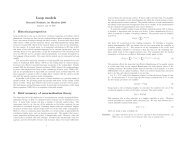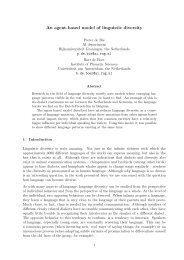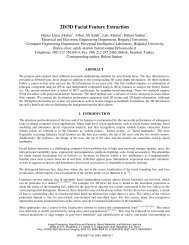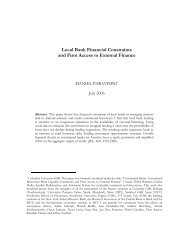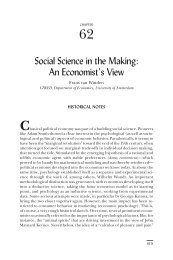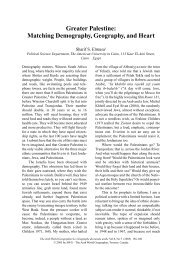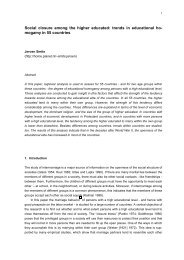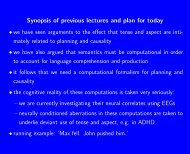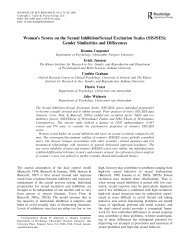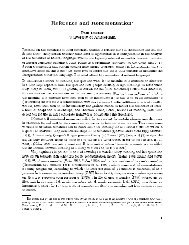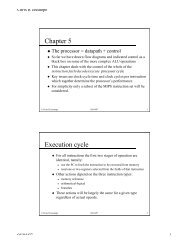The relevance of delivery mode and other programme ...
The relevance of delivery mode and other programme ...
The relevance of delivery mode and other programme ...
- No tags were found...
Create successful ePaper yourself
Turn your PDF publications into a flip-book with our unique Google optimized e-Paper software.
46 BLOK ET AL. / EFFECTIVENESS OF EARLY CHILDHOOD EDUCATIONas no significant unique relationships were found for these<strong>programme</strong> characteristics.Manuscript received March 2003Revised manuscript received May 2004PrEview publication October 2004ReferencesStudies marked with an asterisk are included in the meta-analysis.*Baker, A. J. L., Piotrkowski, C. S., & Brooks-Gunn, J. (1998). <strong>The</strong> effects <strong>of</strong> theHome Instruction <strong>programme</strong> for Preschool Youngsters (HIPPY) onchildren’s school performance at the end <strong>of</strong> the <strong>programme</strong> <strong>and</strong> one yearlater. Early Childhood Research Quarterly, 13, 571–588.Barnett, W. S. (1995). Long-term effects <strong>of</strong> early childhood <strong>programme</strong>s oncognitive <strong>and</strong> school outcomes. <strong>The</strong> Future <strong>of</strong> Children, 5, 25–50.Barnett, W. S., Young, J. W., & Schweinhart, L. J., (1998). How preschooleducation influences long-term cognitive development <strong>and</strong> school success: Acausal <strong>mode</strong>l. In W. S. Barnett & S. S. Boocock (Eds.), Early care <strong>and</strong>education for children in poverty: Promises, <strong>programme</strong>s, <strong>and</strong> long-term results (pp.167–184). Albany, NY: State University <strong>of</strong> New York.Blok, H., & Leseman, P. P. M. (1996). Effecten van voorschoolse stimuleringsprogramma’s:een review van reviews [Effects <strong>of</strong> preschool <strong>programme</strong>s: Areview <strong>of</strong> reviews]. Pedagogische Studiën, 73, 184–197.Boekaerts, M. (1999). Self-regulated learning: Where are we today. InternationalJournal <strong>of</strong> Educational Research, 31, 445–457.Bowerman, B. T., Donovan, M. S., & Burns, M. S. (Eds.) (2001). Eager to learn:Educating our preschoolers. Washington, DC: National Academy Press.Bryant, D. M., & Maxwell, K. (1997). <strong>The</strong> effectiveness <strong>of</strong> early intervention fordisadvantaged children. In M. J. Guralnick (Ed.), <strong>The</strong> effectiveness <strong>of</strong> earlyintervention (pp. 23–46). Baltimore, MD: Brookes.Burchinal, M., Lee, M., & Ramey, C. (1989). Type <strong>of</strong> day-care <strong>and</strong> preschoolintellectual development in disadvantaged children. Child Development, 60,128–137.Campbell, F. A., & Ramey, C. T. (1995). Cognitive <strong>and</strong> school outcomes forhigh-risk African-American students at middle adolescence: Positive effects <strong>of</strong>early intervention. American Educational Research Journal, 32, 743–772.Cohen, J. (1988). Statistical power analysis for the behavioral sciences (2nd ed.).Hillsdale, NJ: Lawrence Erlbaum Associates Inc.Farran, D. C. (2000). An<strong>other</strong> decade <strong>of</strong> intervention for children who are lowincome or disabled: What do we know now? In J. P. Shonk<strong>of</strong>f & S. J. Meisels(Eds.), H<strong>and</strong>book <strong>of</strong> early childhood intervention (2nd. ed., pp. 510–548).Cambridge: Cambridge University Press.*Gersten, R., Darch, C., & Gleason, M. (1988). Effectiveness <strong>of</strong> a directinstruction academic kindergarten for low-income students. Elementary SchoolJournal, 89, 227–240.Gilliam, W. S., & Zigler, E. F. (2000). A critical meta-analysis <strong>of</strong> all evaluations<strong>of</strong> state-funded preschool from 1977 to 1998: Implications for policy, service<strong>delivery</strong> <strong>and</strong> <strong>programme</strong> evaluation. Early Childhood Research Quarterly, 15,441–473.Goldstein, H., Rasbash, J., Plewis, I., Draper, D., Browne, W., Yang, M.,Woodhouse, G., & Healy, M. (1998). A user’s guide to MLwiN. London:Institute <strong>of</strong> Education. [http://multilevel.ioe.ac.uk/features/index.html]Gomby, D. S., Culross, P. L., & Behrman, R. E. (1999). Home visiting: Recent<strong>programme</strong> evaluations—analysis <strong>and</strong> recommendations. <strong>The</strong> Future <strong>of</strong>Children, 9, 4–26.Gomby, D. S., Larner, M. B., Stevenson, C. S., Lewit, E. M., & Behrman, R. E.(1995). Long-term outcomes <strong>of</strong> early childhood <strong>programme</strong>s: Analysis <strong>and</strong>recommendations. <strong>The</strong> Future <strong>of</strong> Children, 5, 6–24.*Goodson, B. D., Layer, J. L., StPierre, R. G., Bernstein, L. S., & Lopez, M.(2000). Effectiveness <strong>of</strong> a comprehensive family support <strong>programme</strong> for lowincomechildren <strong>and</strong> their families: Findings from the comprehensive childdevelopment <strong>programme</strong>. Early Childhood Research Quarterly, 15, 5–39.Guralnick, M. J. (1998). Effectiveness <strong>of</strong> early intervention for vulnerablechildren: A developmental perspective. American Journal on Mental Retardation,102, 319–345.Halpern, R. (2000). Early intervention for low-income children <strong>and</strong> families. InJ. P. Shonk<strong>of</strong>f & S. J. Meisels (Eds.), H<strong>and</strong>book <strong>of</strong> early intervention (2nd ed.,pp. 361–386). Cambridge: Cambridge University Press.Haskins, R. (1985). Public school aggression among children with varying daycareexperience. Child Development, 56, 689–703.Hedges, L. V., & Olkin, I. (1985). Statistical methods for meta-analysis. San Diego:Academic Press.*Howell, K. K., Harrison, T. E., Stanford, L. D., Zahn, B. H., & Bracken, B. A.(1990). An empirical evaluation <strong>of</strong> three preschool language curricula.Psychology in the Schools, 27, 296–302.Hox, J. J. (2002). Multilevel analysis. Techniques <strong>and</strong> applications. Mahwah, NJ:Lawrence Erlbaum Associates Inc.*Johnson, D. L., & Walker, T. (1987). Primary prevention <strong>of</strong> behavior problemsin Mexican-American children. American Journal <strong>of</strong> Community Psychology, 15,375–385.*Johnson, D. L., & Walker, T. (1991). A follow-up evaluation <strong>of</strong> the HoustonParent-Child Development Center: School performance. Journal <strong>of</strong> EarlyIntervention, 15, 226–236.*Kagitcibasi, C., Sunar, D., & Bekman, S. (2001). Long-term effects <strong>of</strong> earlyintervention: Turkish low-income m<strong>other</strong>s <strong>and</strong> children. Applied DevelopmentalScience, 22, 333–361.Lazar, I., & Darlington, R. (1982). <strong>The</strong> lasting effects <strong>of</strong> early education: Areport from the Consortium for Longitudinal Studies. Monographs <strong>of</strong> theSociety for Research in Child Development, 47 (nos. 2–3, serial no. 195).*Lee, V. E., Brooks-Gunn, J., & Schnur, E. (1988). Does Head Start work? A 1-year follow-up comparison <strong>of</strong> disadvantaged children attending Head Start,no preschool, <strong>and</strong> <strong>other</strong> preschool <strong>programme</strong>s. Developmental Psychology, 24,210–222.*Lee, V. E., Brooks-Gunn, J., Schnur, E., & Liaw, F. R. (1990). Are Head Starteffects sustained? A longitudinal follow-up comparison <strong>of</strong> disadvantagedchildren attending Head Start, no preschool, <strong>and</strong> <strong>other</strong> preschool <strong>programme</strong>s.Child Development, 61, 495–507.Leseman, P. P. M., Otter, M. E., Blok, H., & Deckers, P. (1998). Effecten vanvoor- en vroegschoolse stimuleringsprogramma’s: Een meta-analyse vanevaluatiestudies 1985–1996 [Effects <strong>of</strong> pre-school <strong>programme</strong>s: A metaanalysis<strong>of</strong> evaluation studies published between 1985–1996]. Nederl<strong>and</strong>sTijdschrift voor Opvoeding, Vorming en Onderwijs, 14, 134–154.Lombard, A. (1981). Success begins at home. Lexington, MA: Heath.*Luster, T., & McAdoo, H. (1996). Family <strong>and</strong> child influences on educationalattainment: A secondary analysis <strong>of</strong> the High/Scope Perry Preschool data.Developmental Psychology, 32, 26–39.MacLeod, J., & Nelson, G. (2000). Programmes for the promotion <strong>of</strong> familywellness <strong>and</strong> the prevention <strong>of</strong> child maltreatment: A meta-analytic review.Child Abuse <strong>and</strong> Neglect, 24, 1127–1149.*Madden, N. A., Slavin, R. E., Karweit, N. L., Dolan, L. J., & Wasik, B. A.(1993). Success for all: Longitudinal effects <strong>of</strong> a restructuring <strong>programme</strong> forinner-city elementary schools. American Educational Research Journal, 30, 123–148.Marcon, R. A. (1999). Differential impact <strong>of</strong> preschool <strong>mode</strong>ls on development<strong>and</strong> early learning <strong>of</strong> inner-city children: A three-cohort study. DevelopmentalPsychology, 35, 358–375.McGuire, J., & Earls, F. (1991). Prevention <strong>of</strong> psychiatric disorders in earlychildhood. Journal <strong>of</strong> Child Psychology <strong>and</strong> Psychiatry, 31, 129–154.McKey, H. R., Condelli, L., Ganson, H., Barrett, B., McConkey, C., & Plantz,M. (1985). <strong>The</strong> impact <strong>of</strong> Head Start on children, families <strong>and</strong> communities.Washington, DC: DHHS.NICHD. (2002). Early child care <strong>and</strong> children’s development prior to schoolentry: Results from the NICHD study <strong>of</strong> early child care. AmericanEducational Research Journal, 39, 133–164.*Olds, D. L., Henderson, C. R. Jr, Cole, R., Eckenrode, J., Kitzman, H.,Luckey, D., Pettitt, L., Sidora, K., Morris, P., & Powers, J. (1998). Longtermeffects <strong>of</strong> nurse home visitation on children’s criminal <strong>and</strong> antisocialbehavior: 15-year follow-up <strong>of</strong> a r<strong>and</strong>omized controlled trial. Journal <strong>of</strong> theAmerican Medical Association, 280, 1238–1244.*Olds, D. L., Henderson, C. R. Jr, & Kitzman, H. (1994). Does prenatal <strong>and</strong>infancy nurse home visitation have enduring effects on qualities <strong>of</strong> parentalcaregiving <strong>and</strong> child health at 25 to 50 months <strong>of</strong> life? Pediatrics, 93, 89–98.Olds, D. L., & Kitzman, H. (1993). Review <strong>of</strong> research for pregnant women <strong>and</strong>parents <strong>of</strong> young children. <strong>The</strong> Future <strong>of</strong> Children, 3, 53–92.Pianta, R. C., Nimetz, S. L., & Bennett, E. (1997). M<strong>other</strong>–child relationships,teacher–child relationships, <strong>and</strong> school outcomes in preschool <strong>and</strong> kindergarten.Early Childhood Research Quarterly, 12, 263–280.*Ramey, C. T., Campbell, F. A., Burchinal, M., Skinner, M. L., Gardner, D.M., & Ramey, S. L. (2000). Persistent effects <strong>of</strong> early childhood education onhigh-risk children <strong>and</strong> their m<strong>other</strong>s. Applied Developmental Science, 4, 2–14.Ramey, C. T., & Ramey, S. L. (1998). Early intervention <strong>and</strong> early experience.American Psychologist, 53, 109–120.*Reynolds, A. J. (1994). Effects <strong>of</strong> a preschool plus follow-on intervention forchildren at risk. Developmental Psychology, 30, 787–804.Reynolds, A. J. (1998). Developing early childhood <strong>programme</strong>s for children <strong>and</strong>families at risk: Research-based principles to promote long-term effectiveness.Children <strong>and</strong> Youth Services Review, 20, 503–523.Reynolds, A. J., Mavrogenes, N. A., Bezruczko, N., & Hagemann, M. (1996).Cognitive <strong>and</strong> family-support mediators <strong>of</strong> preschool effectiveness: Aconfirmatory analysis. Child Development, 67, 1119–1140.*Riksen-Walraven, J. M., Meij, J. T., Hubbard, F. O., & Zevalkink, J. (1996).Intervention in lower-class Surinam-Dutch families: Effects on m<strong>other</strong>s <strong>and</strong>infants. International Journal <strong>of</strong> Behavioral Development, 19, 739–756.Rimm-Kaufman, S. E., & Pianta, R. C. (2000). An ecological perspective on thetransition to kindergarten: A theoretical framework to guide empiricalresearch. Journal <strong>of</strong> Applied Developmental Psychology, 21, 491–511.Royce, J. M., Darlington, R. B., & Murray, H. W. (1983). Pooled analyses:Findings across studies. In <strong>The</strong> Consortium for Longitudinal Studies, As the



